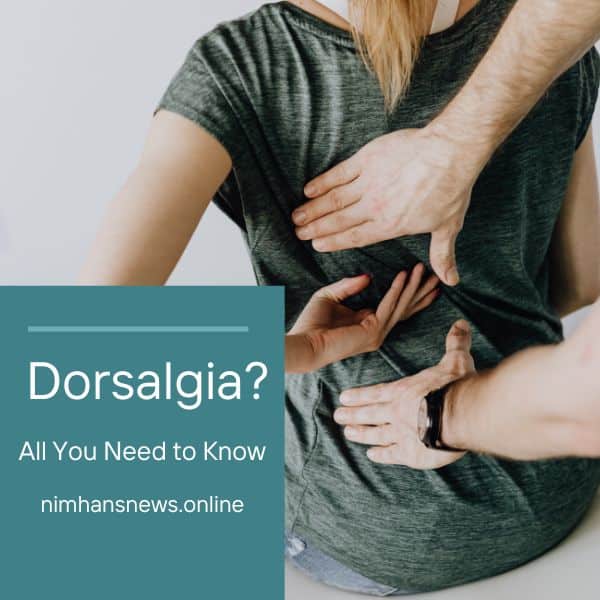Dorsalgia or Back pain is a common problem that many people experience at some point in their life. It can range from minor discomfort to severe and incapacitating pain that impairs everyday activities and quality of life. Back pain can be caused by a variety of factors, including injury, overuse, stress, or underlying diseases affecting the spine or surrounding structures.
What is dorsalgia?
Dorsalgia is a broad term for back or spine pain. It’s a combination of the terms “dorsal” (back) and “algia” (pain). Dorsalgia can cause several types of back pain, including lower back pain, mid-back pain, and sciatica pain. It does not, however, include discomfort caused by certain spinal deformities such as scoliosis or lordosis.
Dorsalgia ICD 10 Code
The ICD-10 code for dorsalgia, which is a general term for pain in the back, is M54.9. This code falls under the category of “Dorsalgia” and is used to classify various types of back pain. It is important to note that the ICD-10 code is used for billing and record-keeping purposes and does not provide a diagnosis or treatment plan.
Classification of Dorsalgia
Dorsalgia is divided into types based on the location and duration of the pain. The following are some examples of frequent types:
1. Thoracolumbar dorsalgia:
This is pain that occurs in the upper and lower back regions, involving the thoracic and lumbar sections of the spine.
2. Thoracic dorsalgia:
This is pain that occurs in the middle back region, involving the thoracic section of the spine. This type of dorsalgia is rare, as this part of the spine is less mobile and less prone to injury.
3. Cervical dorsalgia:
This is pain that occurs in the neck region, involving the cervical section of the spine. This type of dorsalgia can be caused by injury, whiplash, or stress.
4. Cervicothoracic dorsalgia:
This is pain that occurs in the neck and upper back regions, involving the cervical and thoracic sections of the spine.
5. Lumbosacral dorsalgia:
This is pain that occurs in the lower back and buttock regions, involving the lumbar and sacral sections of the spine. This type of dorsalgia can be associated with sciatica, which is pain that radiates down the leg due to compression of the sciatic nerve
6. Lumbar dorsalgia:
This is pain that occurs in the lower back region, involving the lumbar section of the spine. This type of dorsalgia is very common and can be caused by various factors.
What causes dorsalgia?
Dorsalgia can be caused by a variety of factors, depending on the type and location of the pain. The following are some of the most common causes:
Bulging or herniated discs: These are conditions in which the discs between the vertebrae (the bones of the spine) rupture or protrude from their usual position, putting pressure on the spinal nerves or cord. In the affected area, this can cause pain, numbness, tingling, or weakness.
Injury: Trauma, such as a fall, a car accident, or a sports injury, can cause injury to the muscles, ligaments, tendons, bones, or joints of the spine or the surrounding tissues. Inflammation, edema, bruising, or bleeding may occur in the affected area as a result.
Overuse: This can result from repetitive motions or activities that strain or stress the spine or adjacent components. Muscle fatigue, spasms, stiffness, or pain in the affected area may follow.
Stress: This is caused by emotional or psychological factors that impact the neurological system, causing muscle tension or spasms in the spine or adjacent structures. As a result, the affected area may experience pain, tightness, or discomfort.
Underlying conditions:
These are conditions that directly or indirectly impact the spine or adjacent structures. Here are several examples:
Osteoporosis: This is a disorder in which bone density and strength decline, increasing the risk of fracture. It mainly affects the elderly, particularly women following menopause. It can affect any bone in the body, although the spine is the most commonly affected.
Sciatica: This is a disorder in which the sciatic nerve (the body’s biggest nerve) is compressed or irritated as a result of a herniated disc, a bone spur, a tumor, an infection, or other reasons. It causes discomfort to radiate down one or both legs from the lower back.
Spinal stenosis: This is a condition where the spinal canal (the space where the spinal cord runs) narrows and compresses the spinal cord or its branches.
How is dorsalgia diagnosed?
A physical examination and medical testing can be used to diagnose dorsalgia. Your doctor will inquire about your symptoms, medical history, and any lifestyle variables that may be contributing to your back pain. A physical examination will also be performed to examine your posture, range of motion, reflexes, muscle strength, and sensation in the affected area.
They may also request that you practice certain motions or activities that cause or worsen your discomfort. Your doctor may request some medical tests to confirm the diagnosis and rule out other possible reasons, depending on the type and severity of your dorsalgia.
The following are some examples of common tests:
X-rays: These are images that show the bones and joints of the spine and can detect fractures, arthritis, or spinal deformities.
MRI (magnetic resonance imaging): This is a scan that uses a strong magnetic field and radio waves to produce detailed images of the soft tissues and nerves of the spine and can detect herniated discs, spinal stenosis, tumors, infections, or inflammation.
CT (computed tomography) scan: This is a scan that uses X-rays and a computer to create cross-sectional images of the spine and can detect bone spurs, fractures, or other abnormalities.
EMG (electromyography): This is a test that measures the electrical activity of the muscles and nerves and can detect nerve damage or compression.
Nerve conduction studies: These are tests that measure how fast and how well the nerves transmit electrical signals and can detect nerve damage or compression.
How is dorsalgia treated?
Dorsalgia can be treated by various methods depending on the type, cause, and severity of the pain. Treatment aims to alleviate discomfort, reduce inflammation, restore function, and avoid recurrence. Some popular treatment options include:
Physical Therapy: Exercises, stretches, massage, heat or cold therapy, ultrasound, electrical stimulation, or other techniques are used in physical therapy to enhance mobility, strength, flexibility, and posture of the spine and adjacent components. By teaching you optimal body mechanics and ergonomics, physical therapy can also help you avoid subsequent injury or difficulties.
Medications:
These are medications that can help alleviate discomfort, inflammation, or muscular spasms in the affected area. Some examples of common drugs are:
NSAIDs (nonsteroidal anti-inflammatory drugs): These are drugs that can reduce inflammation and pain. Examples are ibuprofen, naproxen, or aspirin.
Acetaminophen: This is a drug that can reduce pain. It is also known as paracetamol or Tylenol.
Muscle relaxants: These are drugs that can relax the muscles and ease spasms. Examples are cyclobenzaprine, baclofen, or diazepam.
Opioids: These are strong painkillers that can relieve severe pain. They should be used with caution and under medical supervision, as they can cause addiction, dependence, or side effects. Examples are codeine, morphine, or oxycodone.
Steroids: These are drugs that can reduce inflammation and swelling. They can be taken orally or injected into the affected area. Examples are prednisone, methylprednisolone, or cortisone.
Dry needling: This is a procedure in which small needles are inserted into certain trigger points or knots in the muscles to relieve tension and pain. It is often referred to as intramuscular stimulation (IMS).
TENS (transcutaneous electrical nerve stimulation): This is a treatment in which low-voltage electrical currents are applied to the skin over the affected area to stimulate the nerves and suppress pain signals. It’s sometimes referred to as electrotherapy or electrostimulation.
Acupuncture: This is a procedure in which fine needles are inserted into certain places on the body to regulate the flow of qi and relieve pain. It is based on traditional Chinese medicinal ideas.
Surgery
This is a procedure that involves making an incision and operating on the spine or the surrounding structures to correct the underlying cause of the pain. Surgery is usually considered a last resort when other treatments have failed or when there is a serious condition that threatens the spinal cord or its branches. Some of the common surgical procedures are:
Discectomy: This is a procedure that involves removing part or all of a herniated disc that is compressing a nerve or the spinal cord.
Laminectomy: This is a procedure that involves removing part or all of a laminar bone that covers the spinal canal to create more space for the spinal cord or its branches. It can also involve removing bone spurs or other growths that are narrowing the spinal canal.
Spinal fusion: This is a procedure that involves joining two or more vertebrae together with metal rods, screws, plates, or bone grafts to stabilize the spine and prevent abnormal movement. It can also involve removing part or all of a disc between the vertebrae to relieve pressure on the nerves or the spinal cord.
Artificial disc replacement: This is a procedure that involves replacing a damaged disc with an artificial one made of metal, plastic, or a combination of both. It aims to restore the normal function and movement of the spine.
How can dorsalgia be prevented or managed?
Dorsalgia can be avoided or controlled by making simple lifestyle adjustments and taking self-care steps that will enhance your spinal health and lower your chance of injury or consequences. Some typical hints include:
Maintain a healthy weight: Excess weight can place extra strain on your spine, increasing your chances of developing back pain or exacerbating existing pain. To maintain a healthy weight, consume a well-balanced diet and exercise regularly.
Improve your posture: Poor posture can cause spinal strain, muscular imbalance, stiffness, and pain. When sitting, standing, or doing any activity, try to prevent slouching, hunching, or twisting your spine. Use ergonomic furniture and equipment to support and keep your spine in a neutral position. Stretch your muscles frequently to reduce tension and increase blood circulation.
Strengthen your core: Your core muscles include the abdominal, back, pelvic, and hip muscles. They serve to support your spine and keep it stable and aligned. By improving your posture, balance, and movement, core muscle strengthening can help prevent or lessen back discomfort. To develop your core muscles, perform exercises such as planks, bridges, crunches, or pilates.
Lifting heavy objects should be avoided: Lifting heavy objects might harm your spine or exacerbate current problems. When lifting something heavy, utilize proper lifting techniques such as bending your knees, keeping your back straight, holding the object close to your body, and lifting with your legs. Avoid twisting your spine or rising above the level of your shoulders. You can also employ tools or gadgets to assist you in lifting big goods, such as carts, dollies, or hoists.
Stress management: Stress can have an impact on your nervous system, causing muscle tension or spasms in your spine or surrounding structures. As a result, the affected area may experience pain, tightness, or discomfort. Relaxation practices such as deep breathing, meditation, yoga, or massage can help you control your stress levels. If you have persistent or severe stress that is affecting your mental or physical health, you can also seek professional support or counseling.
Dorsalgia Exercises
Here are some exercises that can be beneficial for people experiencing dorsalgia:
- Cat-cow stretch: This exercise can help improve flexibility and mobility in the spine. Start on your hands and knees, with your wrists directly under your shoulders and your knees under your hips. Inhale as you arch your back, bringing your head and tailbone towards the ceiling (cow position). Exhale as you round your spine, bringing your chin towards your chest and your tailbone towards your knees (cat position). Repeat for 10-15 repetitions.
- Bridge: The bridge exercise can help strengthen the muscles of the back, hips, and thighs. Lie on your back with your knees bent and your feet flat on the ground. Lift your hips up towards the ceiling, keeping your feet and shoulders on the ground. Hold for a few seconds, then slowly lower your hips back down to the ground. Repeat for 10-15 repetitions.
- Wall angels: This exercise can help improve posture and strengthen the muscles of the upper back. Stand with your back against a wall, with your feet about 6 inches away from the wall. Raise your arms up to shoulder height, with your elbows bent at a 90-degree angle. Slowly move your arms up and down the wall, keeping your elbows and hands in contact with the wall. Repeat for 10-15 repetitions.
- Bird dog: The bird dog exercise can help improve core strength and stability. Start on your hands and knees, with your wrists directly under your shoulders and your knees under your hips. Extend your right arm and left leg out straight, keeping your hips level. Hold for a few seconds, then return to the starting position. Repeat on the opposite side. Continue alternating for 10-15 repetitions.
Conclusion
Dorsalgia is a term that refers to back or spine pain that can have various causes, types, and treatments. It can affect your daily life and well-being if left untreated or poorly managed. Therefore, it is important to consult your doctor if you have persistent or severe back pain that does not improve with self-care measures. Your doctor can diagnose the cause of your pain and recommend the best treatment option for your condition. You can also prevent or manage your back pain by following some simple tips that can improve your spinal health and reduce your risk of injury or complications. By taking care of your spine, you can enjoy a better quality of life and avoid unnecessary pain and suffering.
I hope you found this blog post helpful and informative. I would love to hear your feedback on it. Please let me know what you liked or disliked about it, and if you have any questions or suggestions for improvement. You can leave a comment below or contact me through email. Thank you for reading and have a great day!
FAQs
What is dorsalgia?
Dorsalgia is a medical term used to describe pain or discomfort in the back or spine.
What is dorsalgia unspecified?
Dorsalgia unspecified is a diagnosis code used in ICD-10 to indicate back pain that is not specified as being in a specific region or related to a specific cause.
What causes dorsalgia?
Dorsalgia can be caused by a variety of factors, including poor posture, injury, inflammation, degenerative disc disease, herniated discs, spinal stenosis, and arthritis.
Can cervical radiculopathy dorsalgia be claimed for workers compensation?
Yes, cervical radiculopathy dorsalgia can be claimed for workers compensation if it is caused by work-related activities or conditions.
What is dorsalgia of the lumbar region?
Dorsalgia of the lumbar region is a specific type of back pain that occurs in the lower back, typically between the bottom of the ribcage and the top of the hips. It can be caused by a variety of factors, including injury, degenerative disc disease, herniated discs, and spinal stenosis.
Latest Posts
- Tips for Getting Better Sleep with Anxiety in 2024

- Split Renal Test: The Best Way to Diagnose Dangerous Kidney Problems in 2024

- Revolutionizing Treatment-Resistant Schizophrenia Solutions: Unleashing Hope in 2024

- Demystifying Obsessive-Compulsive Disorder in 2024: Understanding OCD from the Inside Out

- Unmasking the Mind: Can the DAP Test Truly Decode Your Mind in 2023?

